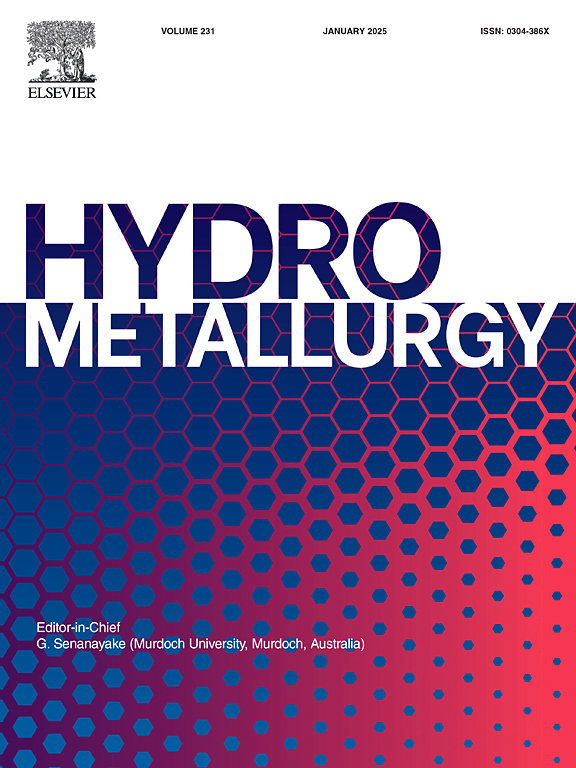利用硫酸焙烧和苏打浸出法生产矿石型碳酸锂的生命周期评估:硫酸钠电渗析的影响
IF 4.8
2区 材料科学
Q1 METALLURGY & METALLURGICAL ENGINEERING
引用次数: 0
摘要
电池和电池化学物质的环境足迹在向脱碳运输的过渡中发挥着重要作用。碳酸锂是一种传统的锂盐,用于制造电动汽车和其他应用的锂离子电池。它主要是从富含锂的卤水或锂辉石矿石中生产出来的,由于矿物加工步骤和高温操作,后者通常更耗能。寻找对环境影响最小的碳酸锂工艺路线对于最大限度地减少整个电池生命周期的环境足迹至关重要。本文对锂辉石精矿采用硫酸焙烧和碱浸两种不同的湿法冶金工艺路线生产碳酸锂进行了基于模拟的生命周期评估。在硫酸焙烧过程中,还对产生的硫酸钠的处理进行了研究,因为硫酸钠是许多工业过程中常见且难以减少的废物。采用文献中描述的电渗析方法,将硫酸钠转化为氢氧化钠和硫酸,在工艺中重复使用,或在生命周期评估中作为可销售产品分配。生命周期影响评估表明,碱浸工艺在所有选择的影响类别中都表现出较低的环境影响,与硫酸焙烧工艺相比,通常可减少40 - 50%。这两个过程中对环境影响最大的来源是能源生产和碳酸钠生产。硫酸焙烧过程中硫酸钠处理方案对环境的影响低于基线方案,但用水量明显高于基线方案。如果可以通过工艺优化和反应效率来减少用水量,电渗析可以被视为一种在现有硫酸焙烧工艺中处理硫酸钠废物的环保可行方法。然而,可以建议,从锂辉石矿石中提炼锂的首选处理策略是在技术上可能的情况下完全避免硫酸盐发电装置过程。本文章由计算机程序翻译,如有差异,请以英文原文为准。
Life cycle assessment of ore-based lithium carbonate production using sulfuric acid roasting and soda leaching: Impact of sodium sulfate electrodialysis
The environmental footprints of batteries and battery chemicals play an important role in the transition towards decarbonized transportation. Lithium carbonate is a conventional lithium salt that is used in manufacturing lithium-ion batteries for electric vehicles and other applications. It is mainly produced either from lithium rich brines or from spodumene ores, the latter being generally more energy intensive due to minerals processing steps and high temperature operations. Finding the process routes for lithium carbonate with the lowest possible environmental impacts is crucial for minimizing the whole battery life cycle environmental footprints. In this work, a simulation-based life cycle assessment was conducted for producing lithium carbonate from spodumene concentrate using two different hydrometallurgical process routes: Sulfuric acid roasting and soda leaching. In the sulfuric acid roasting process, the treatment of generated sodium sulfate was also investigated, as sodium sulfate is a common and hard-to-abate waste from many industrial processes. An electrodialysis method described in the literature was used to convert sodium sulfate into sodium hydroxide and sulfuric acid, which were re-used in the process, or allocated as marketable products in the life cycle assessment. The life cycle impact assessment shows that the soda leaching process exhibits reduced environmental impacts in all chosen impact categories, often reaching a reduction of 40–50 % compared to the sulfuric acid roasting process. The largest sources of environmental impacts in both processes were energy generation and sodium carbonate production. The sodium sulfate treatment scenario in the sulfuric acid roasting process showed lowered environmental impacts when compared to the baseline scenario, except in water use, which was significantly higher. If the level of water use can be curtailed through process optimization and reaction efficiency, electrodialysis could be seen as an environmentally feasible method for sodium sulfate waste treatment in existing sulfuric acid roasting processes. Nevertheless, it can be suggested that in lithium refining from spodumene ore a preferred processing strategy would be to avoid sulfate generating unit processes altogether if technologically possible.
求助全文
通过发布文献求助,成功后即可免费获取论文全文。
去求助
来源期刊

Hydrometallurgy
工程技术-冶金工程
CiteScore
9.50
自引率
6.40%
发文量
144
审稿时长
3.4 months
期刊介绍:
Hydrometallurgy aims to compile studies on novel processes, process design, chemistry, modelling, control, economics and interfaces between unit operations, and to provide a forum for discussions on case histories and operational difficulties.
Topics covered include: leaching of metal values by chemical reagents or bacterial action at ambient or elevated pressures and temperatures; separation of solids from leach liquors; removal of impurities and recovery of metal values by precipitation, ion exchange, solvent extraction, gaseous reduction, cementation, electro-winning and electro-refining; pre-treatment of ores by roasting or chemical treatments such as halogenation or reduction; recycling of reagents and treatment of effluents.
 求助内容:
求助内容: 应助结果提醒方式:
应助结果提醒方式:


